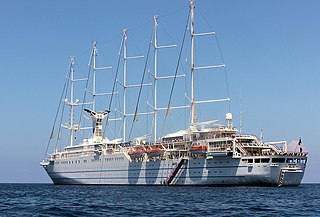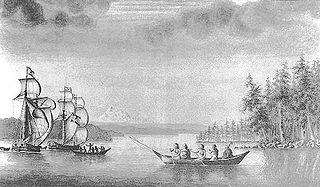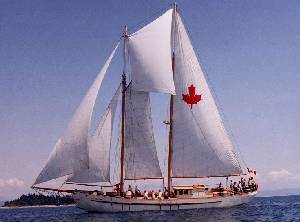
A schooner is a type of sailing vessel defined by its rig: fore-and-aft rigged on all of two or more masts and, in the case of a two-masted schooner, the foremast generally being shorter than the mainmast. A common variant, the topsail schooner also has a square topsail on the foremast, to which may be added a topgallant. Differing definitions leave uncertain whether the addition of a fore course would make such a vessel a brigantine. Many schooners are gaff-rigged, but other examples include Bermuda rig and the staysail schooner.

A sailing vessel's rig is its arrangement of masts, sails and rigging. Examples include a schooner rig, cutter rig, junk rig, etc. A rig may be broadly categorized as "fore-and-aft", "square", or a combination of both. Within the fore-and-aft category there is a variety of triangular and quadrilateral sail shapes. Spars or battens may be used to help shape a given kind of sail. Each rig may be described with a sail plan—formally, a drawing of a vessel, viewed from the side.

The first USS Shark was a schooner in the United States Navy. Built in the Washington Navy Yard to the designs of Henry Steers, Shark was launched on 17 May 1821. On 11 May 1821, Matthew C. Perry was ordered to take command of Shark, and the ship was ready to receive her crew on 2 June 1821.

C.A. Thayer is a schooner built in 1895 near Eureka, California. The schooner has been preserved and open to the public at the San Francisco Maritime National Historical Park since 1963. She is one of the last survivors of the sailing schooners in the West coast lumber trade to San Francisco from Washington, Oregon, and Northern California. She was designated a National Historic Landmark on 13 November 1966.
The West Coast lumber trade was a maritime trade route on the West Coast of the United States. It carried lumber from the coasts of Northern California, Oregon, and Washington mainly to the port of San Francisco. The trade included direct foreign shipment from ports of the Pacific Northwest and might include another product characteristic of the region, salmon, as in the schooner Henry Wilson sailing from Washington state for Australia with "around 500,000 feet of lumber and canned salmon" in 1918.

Zodiac is a two-masted schooner designed by William H. Hand, Jr. for Robert Wood Johnson and J. Seward Johnson, heirs to the Johnson & Johnson pharmaceuticals fortune. Hand intended to epitomize the best features of the American fishing schooner. The 160-foot-long (49 m), 145-ton vessel competed in transatlantic races. In 1931 the vessel was purchased by the San Francisco Bar Pilots Association, brought from the Atlantic, modified and placed in service as the pilot vessel California serving as such until retired in 1972.

Black Douglas is a three-masted staysail auxiliary schooner built for Robert C. Roebling at the Bath Iron Works of Bath, Maine, and launched on 9 June 1930. Designed by renowned New York City naval architects H.J. Gielow & Co., she is one of the largest steel-hulled schooners ever built.

The Sail and Life Training Society (SALTS), founded in 1974, is a non-profit Christian organization based in Victoria, British Columbia. SALTS provides sail training and life lessons for 1,700 young people each year on tall ships and provides a valued link to the area's maritime heritage. Currently, SALTS administrative offices are located on Herald Street in downtown Victoria, with a shop space located nearby in the Rock Bay area.

Club Med 2 is a five-masted computer-controlled staysail schooner owned and operated by Club Med and operated as a cruise ship. It combines the power of seven computer-operated sails with more traditional diesel-electric power, having four diesel generators that power two electric motors. Club Med 2 was launched in 1992 in Le Havre, France. Her sister ship Club Med 1 was sold to Windstar Cruises and renamed Wind Surf in 1998.

The three-masted schooner Victory Chimes, also known as Edwin and Maud or Domino Effect, is a US National Historic Landmark. She is the last surviving Chesapeake Ram schooner. The boat on the Maine State Quarter is meant to resemble the Victory Chimes.

Sutil was a brig-rigged schooner built in 1791 by the Spanish Navy at San Blas, New Spain. It was nearly identical to Mexicana, also built at San Blas in 1791. Both vessels were built for exploring the newly discovered Strait of Georgia, carried out in 1792 under Dionisio Alcalá Galiano, on Sutil, and Cayetano Valdés y Flores, on Mexicana. During this voyage the two Spanish vessels encountered the two British vessels under George Vancouver, HMS Discovery and HMS Chatham, which were also engaged in exploring the Strait of Georgia. The two expeditions cooperated in surveying the complex channels between the Strait of Georgia and Queen Charlotte Strait, in the process proving the insularity of Vancouver Island. After this first voyage Sutil continued to serve the San Blas Naval Department, making various voyages to Alta California and the Pacific Northwest coast.

Charles Ernest Nicholson was a British yacht designer.

Matthew Turner was an American sea captain, shipbuilder and designer. He constructed 228 vessels, of which 154 were built in the Matthew Turner shipyard in Benicia. He built more sailing vessels than any other single shipbuilder in America, and can be considered "the 'grandaddy' of big time wooden shipbuilding on the Pacific Coast."

Aquilo was a steam yacht which was built in Boston in 1901 for William Phelps Eno, a wealthy man who was the inventor of the stop sign. In 1910, Eno sold Aquilo and the yacht was brought to the west coast of North America, where it was operated principally in Puget Sound and coastal British Columbia. Aquilo had a long succession of wealthy owners. In 1966, the yacht caught fire and sank while en route from Seattle to Los Angeles.

Amazing Grace is an 83' topsail schooner. Its home port is in San Juan, Puerto Rico. The ship serves as the platform for the non-profit Maritime Leadership and is also available for private charters and memorials at sea. Maritime Leadership provides traditional sail training adventures through sailings ranging from 3–48 hours.

MSY Wind Surf is a five-mast staysail schooner that is one of the largest sailing cruise ships in the world, with two electric propulsion motors powered by four diesel electric generating sets also. She can carry up to 342 passengers, in a total of 150 ocean-view staterooms, 18 ocean-view suites and 2 deluxe bridge suites, with a crew of 210. Wind Surf had been owned and operated by Club Med under the name Club Med 1, and was later transferred to Windstar Cruises.
The following outline is provided as an overview of and topical guide to sailing:

The Harvey Gamage is a 131' gaff rigged schooner launched in 1973 from the Harvey F. Gamage Shipyard in South Bristol, Maine. She was designed by McCurdy & Rhodes, Naval Architects in Cold Spring Harbor, New York and Frederick W. Bates of Damariscotta, Maine. She is a USCG inspected vessel both as a passenger vessel and a sail training vessel. As governments of maritime countries recognise Sail Training as an essential component of developing and maintaining an essential merchant marine force, the US Congress created a special service category of vessel for Sail Training and the Harvey Gamage is one of a handful of vessels licensed for this service. She has been educating students at sea along the east coast of North American almost continuously since her launch. She has 14 staterooms accommodating 39 people, including 9 professional crew, 22 youth sail trainees and up to 4 adult chaperones. As a training vessel, she takes crews of students along the eastern seaboard, from her home port in Maine to various destinations ranging from The Maritimes to the Caribbean

A sail plan is a drawing of a sailing craft, viewed from the side, depicting its sails, the spars that carry them and some of the rigging that supports the rig. By extension, "sail plan" describes the arrangement of sails on a craft. A sailing craft may be waterborne, an iceboat, or a sail-powered land vehicle.

















